By Jim Davis
Why use a dummy gun? The reasons are many, but this question is probably the most significant.
“Is it unloaded?”
Your partner assures you that it is. Do you trust him? I mean, really trust him? Because even if he’s 100% trustworthy, accidents and negligence happen.
You’re going to want to check that there is no magazine in place and that the chamber is empty. And then check it another few times. In fact, the procedure when using weapons in training is to have all parties present check to verify that any given weapon being used is, in fact, safe. And ensure that there’s no live ammunition anywhere near the area.
You know what’s better yet? Don’t use real weapons in training at all.
In 2019, three police officers were reportedly killed by gunfire during training accidents. That’s just in one year. Over the years, the number of needless deaths has been shocking and sad. Simply put, such deaths are completely avoidable. They just do not need to happen.
A few years back, a large city not far from where I live suffered one such tragic loss. Officers were conducting training in a classroom, an “unloaded” gun was fired, and a death resulted.
What can be done to prevent these kinds of dangers? One great option is the use of a dummy gun, something often referred to as a “rubber duck.” ASP (Armament Systems and Procedures) meets this need in the form of their “red guns.”
ASP manufactures replicas of most common duty weapons, including pistols, rifles, submachine guns, and shotguns.
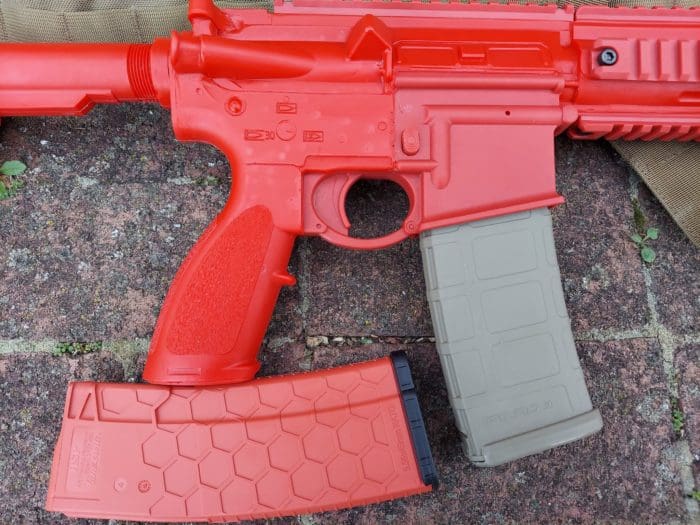
For years, these have been helping people in the law enforcement community train safely and effectively. Now ASP has stepped up their game in the form of enhanced red guns. These newer models feature magazines that can be inserted and dropped free, which adds more training options.
The “firearm stand-in” that I received for evaluation is the Enhanced Red Gun in the form of the H&K 416, which resembles most AR-15 and M-4 carbines. The controls are placed just like the real thing. The only one that works is the magazine release. On top of that, the rail system on the top of the receiver and the sides and bottom of the forend are removable.
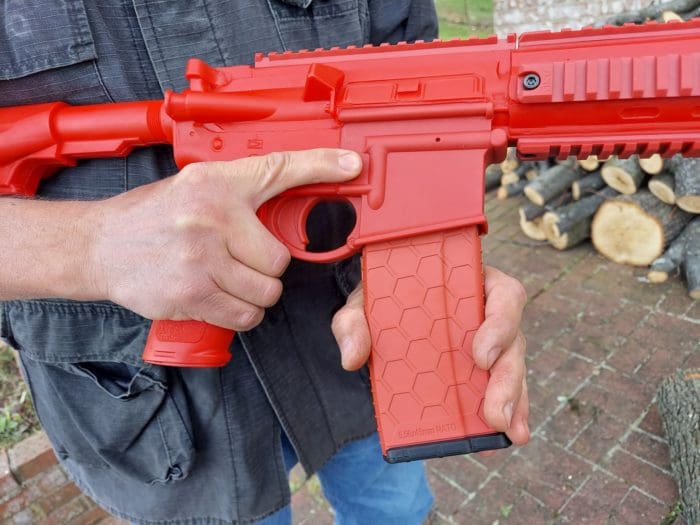
Any accessories that are normally used on an individual rifle can be added to these rails. Thus you can add your lights, lasers, red dots, scopes, etc. so your training can be as realistic as possible without endangering anyone.
The user can also remove the rails to reconfigure a rifle to his liking.
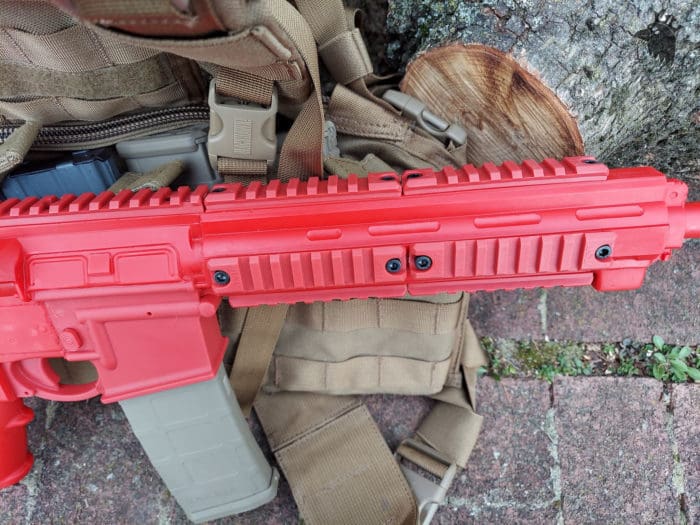
The sample that I received came with two magazines that resemble those from PMAG, although they are not functional. Just out of curiosity, I grabbed a real PMAG and tried it in the trainer, and it worked perfectly! It’s always nice to be able to practice with the mags you will carry if you want. So now users can practice magazine changes without danger to others.
The red color of these trainers makes it impossible to mistake them for the real thing. Their size and dimensions are precisely like their real life counterparts, although the weight isn’t exactly the same; the training guns are actually slightly lighter than the real thing (although not by a lot).
The balance on the 416 is also slightly off from the real thing. It’s more butt-heavy than muzzle-heavy, which isn’t like the actual HK rifle. Despite that, they will suffice for the intended purpose. As we used to joke on the job, “It’s close enough for government work.”
Aside from the inherent safety, what are some of the added benefits of using red guns for training? Well, a dummy gun won’t corrode (no metal parts), since they’re constructed of steel-reinforced polymer.
And of course, they’re less expensive to replace. If you break a training gun, it’s far less costly than breaking a real H&K 416. Let’s say a trainee is rappelling down a wall and the dummy gun is dropped — at least a real gun isn’t being trashed or sent for a lot of work to an armorer or gunsmith.
On that note, I’ll point out that ASP covers these training tools with a limited lifetime warranty in the event any of their products are found to be defective in materials or workmanship.
If a red gun is dropped on a floor, it won’t mar the floor the way an actual firearm would. Similarly, the polymer gun won’t harm people as much as a metal firearm if it comes in hard contact with their body, considering that polymer is softer than steel.
This really matters during weapons retention training, which typically becomes extremely physical if done correctly. Because of this, injuries can be reduced by using the red guns.
In 2018, four police officers were murdered by suspects who disarmed them and used their own weapons against them, accounting for approximately 13% of the police fatalities for that particular year. Weapon retention is (or at least should be) a huge concern and focus of training for police and corrections personnel.
When I worked in Corrections, we lobbied for years to have weapon retention instruction included in our Use Of Force training blocks, and for a long time it fell upon deaf ears. After years of effort, we were finally successful in convincing management that this was a real issue that needed to be addressed.

They ultimately relented, and eventually included a small block of retention techniques, albeit the barest minimum that they could squeak by with. Nevertheless, we took the ball and ran with it, making the best out of a mediocre package that we could.
These enhanced red guns will go a long way in providing the necessary tools for retention training.
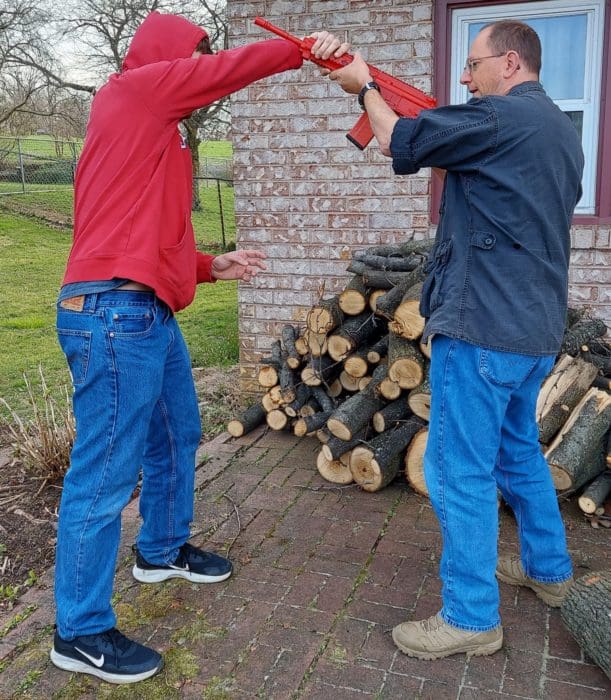
Generally speaking, if a perpetrator or suspect grabs an officer’s weapon, it’s instantly a dire situation. That officer is now fighting for his or her life. If the weapon is a handgun still in its holster, simple strikes and grappling will likely be used for the officer to retain his weapon.
Moving through a structure or in close proximity to bad guys exposes us to additional threats because perps might make a grab for a long gun if that is what we’re deploying.
We all want to respond with, “I’m going to use superior tactics so that no perp will get close enough to grab my weapon!” Let’s face it, though. Stuff happens.
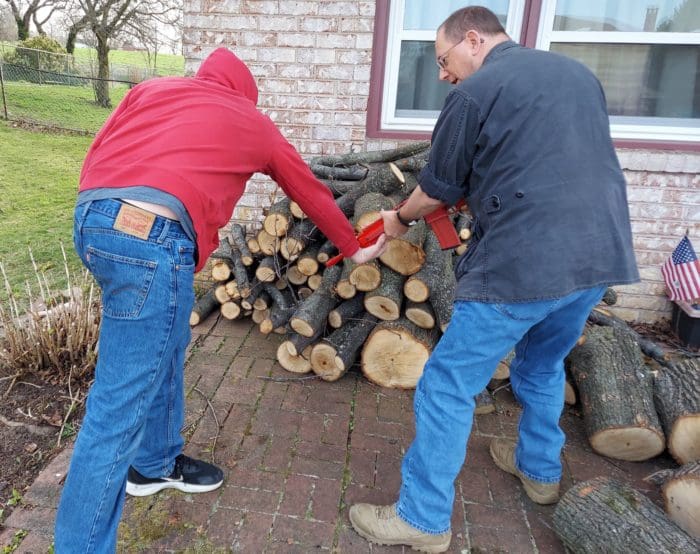
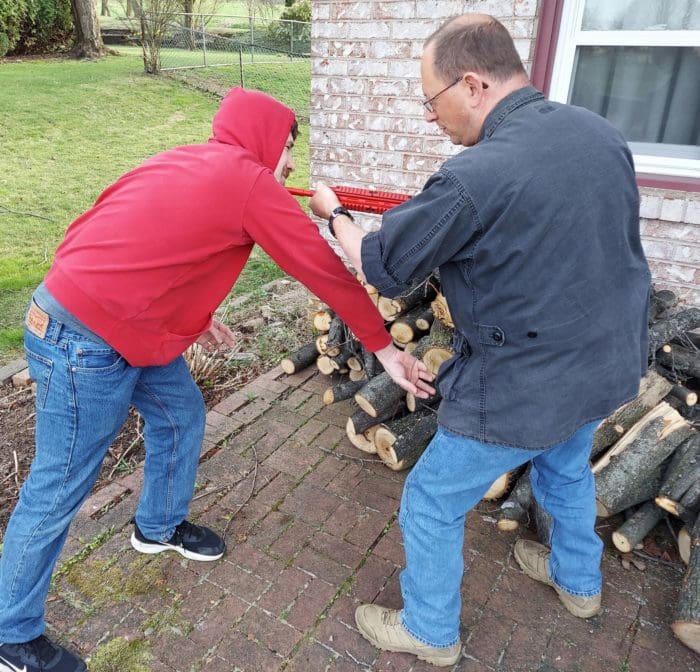
Sure, in our minds we’re all brilliant technicians, but this is the real world. Moving down a hallway with rooms on either side can set us up for a gun grab, and we’d better be well versed in how we’re going to respond.
If the barrel is grabbed, circular movements will usually be the way to go because they work against a suspect’s wrist mechanics and can break their hold. Which way you rotate the barrel will depend on the bad guy’s position and angle of attack. The key is to take action and not freeze because if you freeze, you will likely die.
You know what helps you to train hard and realistically for such a dire situation? A dummy gun.
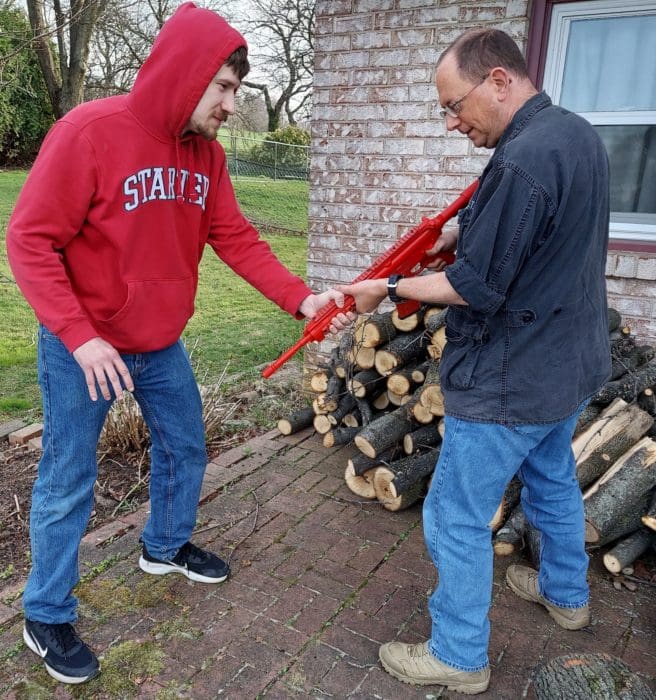
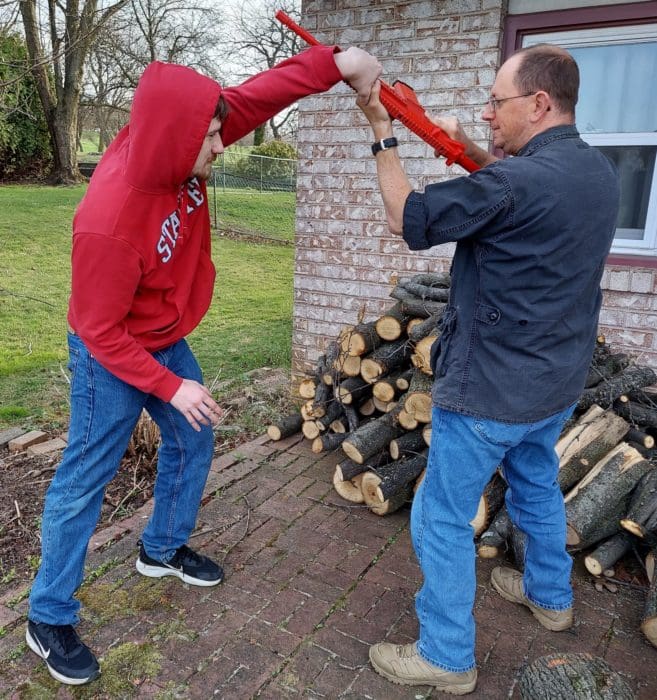
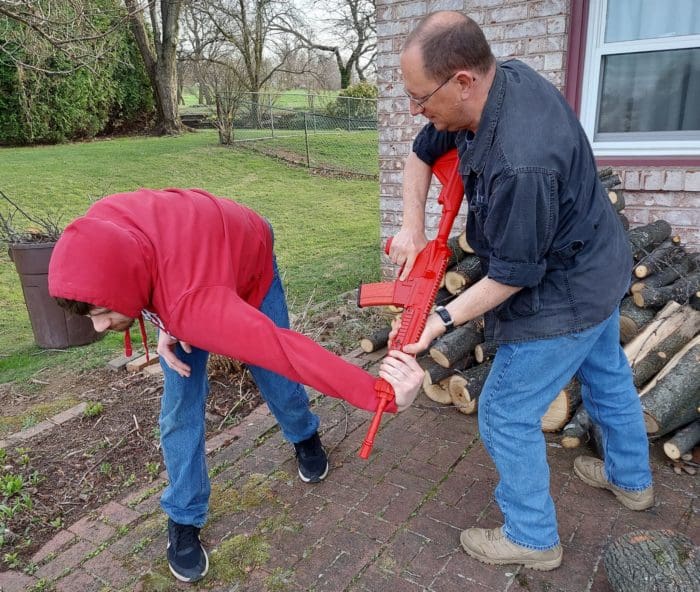

Check out ASP’s enhanced red gun line, they’re well worth the look.
At the time of this writing, the HK 416 red gun is priced at $355.
Jim Davis served in the PA Dept. of Corrections for 16½ years as a corrections officer in the State Correctional Institute at Graterford and later at SCI Phoenix. He served on the Corrections Emergency Response Team (CERT), several of those years as a sniper, and also the Fire Emergency Response Team (FERT). For 25 years, he was a professional instructor, teaching topics including Defensive Tactics, Riot Control and Tactical Operations, Immediate Responder, and cognitive programs as an adjunct instructor at the DOC Training Academy.

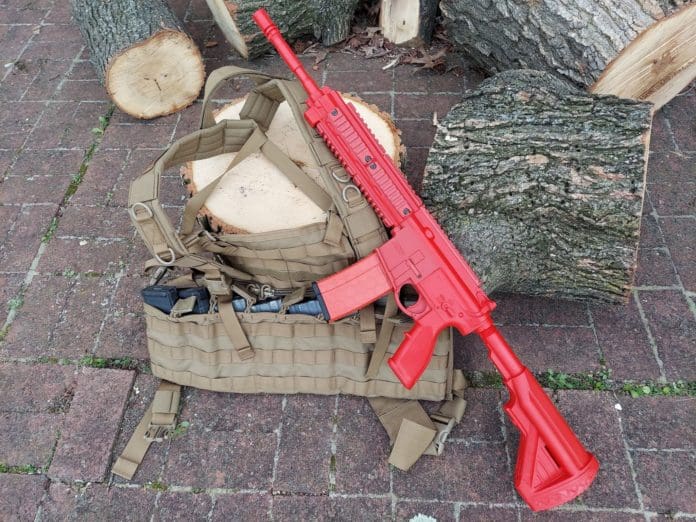



I prefer to think of the “Four Rules” as the four “disciplines”.
The notion that “the gun is always loaded” simply can’t be adhered to as a “rule”. For example, when cleaning and inspecting the rifling. By framing it as a “rule” the semantics of the term chosen is immediately undermined by a never entirely complete list of exceptions.
When you frame it as a “discipline” the called-for behavior is much different. For example, even when using a dummy gun or an air-soft gun, you handle it as though it were a loaded gun in all cases EXCEPTING ONLY those occasions when there is no viable alternative. E.g., when training for retention skills. Maintain the habit of treating it as-if it were a real gun (even though it is obviously not real) in all other cases where it IS FEASIBLE to handle it as-if it were real.
Most of us won’t invest in building an armory of several guns (a rifle + shotgun + revolver + pistol). In a multiple student environment, multiply by 3 or 6; gets expensive quick.
In such scenarios, one might consider chamber flags to conspicuously identify the gun as not-loaded. Or, for a revolver, a red dowel known to be long enough to fill the chamber when fully inserted. In all handling up to – and then following – the specific exercise (retention skills) treat the flagged real-gun as-if it is “real” and therefore, might be loaded.
“The gun is always loaded, unless you’ve personally checked it when you picked it up” is not *that* difficult to remember… Don’t try to complicate these things.
I disagree. If I’ve disassembled it for cleaning, it’s no longer a firearm. If I’m just running a boresnake through it, then I treat it the same as I do if I have a loaded magazine and one in the chamber. If I need to inspect the rifling, I do it on the barrel, not on the firearm unless I can look down from the breech end or use a borescope (also from the breech end), but then I’d be adhering to the rule.
One thing for certain if you are the kind of nitwit on ar15.com who advises someone with a pivot pin that is far from engaging the detent that they are GTG you ain’t touching a firearm around me.
My advice is to have a designated range master among shooters who are capable of being range masters themselves. I.E…Before anyone goes down range to measure and tape holes all weapons are cleared, bolts open and all shooters have stepped away from the bench. Until everyone is in their place only then does the taper proceed down range. Until the taper is safely back behind the line of fire no one returns to the bench. It all runs like clockwork or stay home.
In the military ALL troops go downrange to tape, problem solved.
Range officers and rubber rifles go hand in hand in initial training. After that a lot of us avoid them both. If municipal or state employees tend to have problems with shooting each other, then go ahead, issue rubber rifles for training. It’s cheaper than having to train another replacement.
I don’t expect we’d get better ones who don’t shoot each other. That would be too expensive.
$355?!? Geez I only paid $400 for my AR. And gotta nice AR carrier thrown in. A BB gun would work a mitecheaper…
A Red Ryder BB gunm at that.
A chamber flag would be cheaper still. Or a cheap complete upper receiver with the chamber spiked and barrel plugged with something red- swap it onto your lower and go to work. And you’d have the benefit of training with your *real* rifle.
Definitely priced for taxpayer dollars.
Grab a quality airsoft or pellet replica for half the price and you can actually shoot it.
Or for the real poors there’s: http://www.sturdiguns.com
Never had anything that nice for training but the guard competed with the marines for leftovers even post 9/11 for most things except those power points. Those were more numerous and obnoxious than what I have to go through here in NY. As to your poors option I laughed then realized it would work equally well for low budget units as well as leaving on the playground to the kids delight and the mama Karen’s stroke.
NO BIG RED FOR ME , $$$ , NEED 22LR AMMO
The problem with these guns is not all criminals are stupid.
You take a Glock and paint it blue. It looks like a training gun.
It isn’t, it’s an honest to goodness Glock that fires and everything.
The fact that it’s blue buys a criminal extra time to get the drop on you.
If you work in bad area of say Chicago, you learn the street tricks.
Your brain wants you keep your eyes on the 20 something gang banger.
The truth of the matter is it’s the 14 year old that’s going to shoot at you.
He may shoot you if you let him get close enough.
This is situational awareness that is not often taught but becomes learned.
Work on the Westside or Southside of Chicago for a while.
I would hope that an officer’s training would have them fire when a gun-shaped object was brought to bear. At night, the difference between red, blue, or a standard colored gun is nonexistent.
That’s the way it was with the “old” breed of cop. I’m mostly talking about during the day, a difference in color can make anyone hesitate. It doesn’t make anyone dumb or untrained, it’s a street tactic used to slow your reaction to draw time.
Besides I worked on the Westside but not as a cop. I worked in a very cash heavy business and dealt with people on the street all the time. I carried a gun well before Illinois passed any concealed carry act, most people in my business did. The CPD actually encouraged it, I bought a Beretta Cheetah from a detective. I bought a 92 from a tactical cop. I carried a business card signed by Richard M Daley. I carried my business cards. We had a 870 in the store that was brought out on the street daily, especially when large amounts of cash were coming in or going out.
Nowadays I live and work far from there but take the case of Adam Toledo. A 21 year old and 13 year old Adam Toledo are shooting a Ruger at 2:00AM. Gunfire detectors (ShotSpotter) go off and the CPD are on the next block watching two men shooting a gun. The CPD come out of a gangway between two houses and order them to stop and lay down. Adam Toledo takes off with the Ruger in hand while Officer Eric Stillman gives chase.
A 32 year old officer chases down a 13 year old who had a gun in his hand. It all comes to end near a fence and Eric Stillman orders Adam Toledo to show his hands.
When he brings up his hands it does look like he had the Ruger in his right hand and Stillman had 8/10ths of a second to make a decision. Shoot or not? He shot one shot right into Toledos chest. The whole time Stillman had his gun drawn with light on Toledo.
When the body cam footage is slowed down it appears that Toledo ditched the gun a second before he stopped. Still man had 832nds of a second to react. It was a by the book shoot. The problem is that Stillman still caught grief over it and did not know if the mayor or CPD Superintendent would stand behind him.
This is the mayors statement: “I don’t want to get into the real substance of this because the independent investigation is going on, but I’ve seen no evidence whatsoever that Adam Toledo shot at the police,” Lightfoot said.
Toledos family hired an attorney. They plan on suing. This the attorneys statement after watching slow motion footage of the shooting: “At the time Adam was shot, he did not have a gun. OK?” his family’s attorney, Adeena Weiss-Ortiz, told reporters Thursday afternoon. “In that slo-mo version (of one of the videos), whatever he had in his, in his hand, whether it was a gun or something else, there was something in his hand, he approaches the fence, he lets it go, he turns around, and he’s shot.”
Here’s the question for you. If the gun looked like a trainer and the cops weren’t on the scene and saw them actually shooting the gun, add some time to 8/10s of a second. Add two seconds. Stillman is going to draw but sees a blue trainer gun. That blue gun adds two seconds to his decision/reaction time.
Does Stillman take fire in 2.8 seconds?
I was told about painting guns and putting red plastic caps in the end of guns from a gangbanger who was a Gangster Disciple. This was many years ago. The tactical cop knew about this, the detectives did not. The tactical cop killed two people in the line of duty but his partner was also killed in the line of duty.
An officers training is mostly done on the job. After 18 months on the job they are still wet behind the ears. Years of experience are what makes them proficient. Even after many years on the force not all are proficient.
Your comment is an oversimplification especially in the political climate now. Go back 20-30 years and you would be correct. If you shot someone as a CPD and they were unarmed, you just planted a drop gun. Today everyone and their dog has a smartphone. Basically your shoot better be 110% “righteous” now or you go to jail.
can’t dry fire that thing.
They had to issue a fake rifle to a cadet when I was in ROTC because he kept setting down and losing real M16s. You’d think they’d have kicked out someone like that but in the ’80s they were so desperate to keep the numbers up they didn’t.
Wasn’t just the 80s. Spend all day on the range so shitbags can qualify. Over, and over, and over, and over. I’ve literally sat on a lane next to these idiots and shot their fucking targets just so we can go home. That’s why when someone says “I did this job in the military” it doesn’t mean shit. Even heard “infantry” fucksticks say they were infantry like it made them better than someone else, when I’ve seen “infantry” types do a full deployment of gate guarding and been involved in training for their deployments.
Gonna paint an AR red as fuck now.
A RifleBlok from BarrelBlok is also a good option. Fills the barrel and chamber with an orange or red polymer rod. Stick out from the barrel to demonstrate that the firearm is disabled.
Includes dummy bullets with a channel cut in them so that the BCG doesn’t load the round, eject the round or allow the mag to hold the bolt open.
$17.99 – Search for “RifleBlok”
I’m of mixed opinion on dummy guns. Mainly because many of them do not simulate real mechanical action.
Call it the 4 Rule, Disciplines, Dictates, Laws, Maxims or whatever “some antics” you want, following the 4 Whatevers must be a taught habit, not a situational habit (personally I prefer 4 Commandments). Watching someone perform the cleared action checks does not give you license to not perform those same checks in the seconds after the gun is exchanged.
As a civilian, my exposure to faux substitutes has been very limited, so I really don’t feel qualified to offer an opinion on whether they should/should not be used. From childhood, I was taught gun handling in a controlled environment, and that’s how I taught my children, and now my Grandchildren. It was 100% successful, as there was never even a near miss in my lifetime.
It’s a great tool when available or affordable but….
Comments are closed.